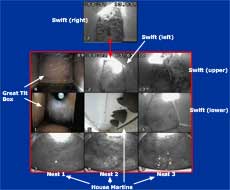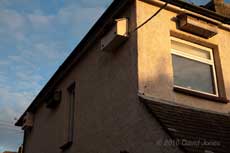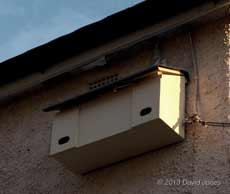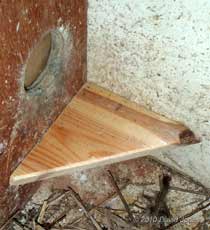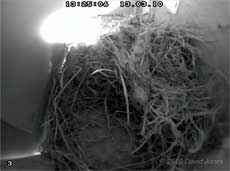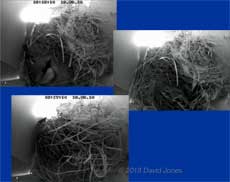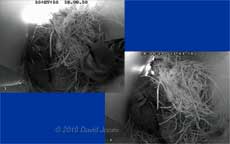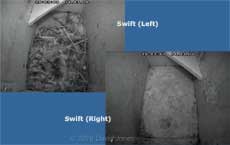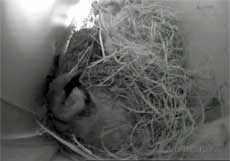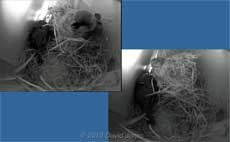Go to the last entry on this pageA look back at 2009As with the previous year, the 2009 nesting season was one of mixed fortunes, although it culminated in an end which promised much for 2010. Mid-March we saw the Great Tits begin nest building, although by this time the Robins were already well under way. Sadly, it seemed that the Robins' clutch of eggs was infertile, and even though the female continued to incubate for about two weeks extra, they failed to hatch. When she finally gave up it took the male several days before he stopped brining food to the nest for her. The Great Tits had a decent sized clutch of nine eggs, but finding enough food seemed to be a problem for the eight that hatched, and only four chicks made it to fledging on 14 May. However, no sooner had they gone than the parents produced a second brood of six eggs. This time they were more successful with five chicks fledging in mid-June. On 8 April a pair of Starlings produced the first of five eggs in their nest box on the north side of our house. Just like the Great Tits they too had problems with food supplies, and there was only one chick that survived to fledge on 16 May. After that the adults left the box(es) and made no attempt to start a second brood. Throughout the nesting season I should point out that there were also at least three pairs of House Sparrows nesting in boxes un-monitored by me. After the disappointments of the first part of the nesting season it was a case of fingers crossed for the return of the House Martins and Swifts from Africa. For the second year the Martin boxes remained empty, apart from a roosting Blue Tit. And when the Swifts returned to my neighbour's loft, none appeared in my boxes, at least, not until it was time for immature Swifts to seek out nest sites for themselves ready for the future! In early June I noticed that a pair of Sparrows had moved into the upper Swift box and were nest building in there. Fortunately that was good enough an excuse to maintain continuous video recording of the Swift and Starling boxes, in case they moved into them too. Then, during the second half of June we noticed an increase in Swift aerobatics around the house and driveway, culminating in me spotting a Swift investigating the Swift boxes on the 21st. The nest day I saw a Swift inside a box for the first time - the one used by the starlings! Within a couple of days we had pairs roosting in the left hand Starling box and the upper Swift box, having ejected the Sparrows. The Swifts stayed with us into the first few days of August, during which time we were treated to courtship behaviour that I'd never seen before in our nest boxes, as well as their somewhat fragile nest building - amazing! Whatever disappointments we had earlier in the season were washed away by that 'Swift experience'. The 2010 Nesting Season - an Introduction I've been a bit slow to get started this year, although the cold winter seems to be slowing the birds down too. As I write this in mid-March, I now have ten cameras running, covering eight nest boxes. The cameras are connected to a hard drive recorder via multiplexer, although to squeeze ten cameras into nine sectors I have to use a second multiplexer to alternate views between two of the cameras (the Swift right/left cameras at the moment). I will not be setting up a webcam until there is definite nesting activity to be followed.
I have modified the Starling boxes by adding a plywood panel to cover the original entrance and then cutting out a much lower, Swift friendly entrance that measures 65x35mm.
Inside each box I have added a small ledge just above the new entrance as an obstacle for any Starling that decides to enter the box. While I cleaned out the Starling nest from the right hand box, I decided against interfering with the structure produced by the Swifts.
In an ongoing optimism that the House Martins will return eventually, I have replaced the lenses in those cameras with wide angle, 2.1mm lenses to give better coverage in the confined space. So far this Spring they have only been tested by a House Sparrow that roosted for a single night. I've also put the same type lens in Swift box (upper). I need to get one more to put into the lower box. I am also in the process of improving the lighting in the Swift boxes, although that task may have to be curtailed because of on going Sparrow activities. I believe that the Robins are nesting somewhere in out Ivy tree, but it is not in a nest box and so will not be monitored this time.
13 March - With Sparrows in continuous possession of Swift box (upper) since last summer, I haven't attempted to remove the nest that they built and which was modified by the Swifts last June.
The clear circular area bottom left was cleared by the Sparrows, and the female usually roosts there while her partner rests next to the entrance (see below). The lighter circular area you can see upper-right was created by the Swifts.
The Sparrows usually leave their roost by around 7am but return frequently during the mornings. While they are away from the nest for longer in the afternoons they are back in to roost by 4pm. Today I noticed a change in behaviour. There was more shuffling going on during visits by the male during the late morning, and perhaps coincidentally, I saw a Sparrow pulling at straw in the garden.
Anyway, in the middle of the afternoon the male was particularly active in the box, diving under the straw and ending up shifting the Swift ring much nearer to the entrance before clearing the corner again.
Here are before and after images to show the change that he made to the nest.
When he perched immediately above her there was a brief clash of beaks.
It will be interesting to see if this pair does go ahead and produce eggs, especially if they can resist the temptation to build a dome over the nest cup....
14 March - Just a short entry today - I have now completed setting up the converted Starling boxes by installing new infra-red LEDs. There are two LEDs in each box and to avoid 'hot-spots' that LEDs tend to produce they point upwards towards white plastic sheets that are stapled to the lids.
If the boxes are used I will probably abbreviate the names to SWle and SWri, while the original Swift boxes will be referred to as SWup and SWlo. I need to give more attention to the lighting in those boxes. I hope to complete that tomorrow when I see that the Sparrows' attention is elsewhere. The Sparrows left SWup at 6.55am this morning and over the next two hours they returned to the box frequently as a pair. However, the female didn't appear when the male returned at around 10.30am and over the next half hour made numerous visits during which he seemed to be working on the space occupied at night by his partner. He repeated the process over another half hour period from around 11.20am before disappearing for the afternoon. Both birds arrived to roost at 3.56pm and once in the box the female went straight to 'her' corner. The male briefly perched above her (as shown yesterday) and then settled for the night next to the entrance. Again there was no activity at all at the Great Tit box.
15 March - A mainly bright and sunny day with the temperature perhaps 14C or more in the garden. After the usual morning activities in the Sparrows' box, I took advantage of their absence in the early afternoon to change the LEDs in the two Swift boxes.
She spent some time inspecting the LED arrangement, although she didn't find it necessary to take a closer look.
The male, in the meantime, is in his usual spot by the entrance.
I see that Hampshire County Council is running the Hampshire Bird Festival this year, and as part of it they are running a House Sparrow survey between March and June. I shall be adding my observations to that survey. Once I get the Swift boxes put up on my neighbours' houses I'm keeping my fingers crossed that Sparrows will at least use them as roosts over the years to come. Over the last week at least two more householders in our road have had wooden soffits and fascias replaced with PVC, so I guess that a few more birds have lost their homes! There is still no activity in the Great Tit nest, but I have seen the male Robin taking food into the Ivy tree, confirming that nesting is under way in the garden.
- Click on the images to see larger versions - |
|
